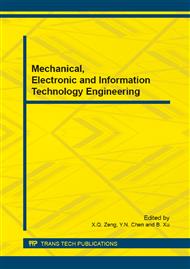[1]
Xu Zhonghua, Wang Jianhua, Wang Weidong, Deformation behavior of diaphragm walls in deep excavations in Shanghai, China Civil Engineering Journal, 2008, 41(8): 81-86.
Google Scholar
[2]
Zhang Bin, Inclining Monitoring of Some Super-large Deep Foundation Excavation, Construction Technology, 2011, S2: 28-31.
Google Scholar
[3]
Dai Shengshan, Li Tianfeng, The Development And Application Prospects For Grand Three-dimensional Laser Scan Technology, Modern Surveying And Mapping, 2009, (04): 11-12+15.
Google Scholar
[4]
Xie Yuanyuan, 3D Laser Scanning Technology and Its Application in Measurement, Value Engineering, 2012, (15): 209.
Google Scholar
[5]
M. Lemmens, Terrestrial Laser Scanning, Geo-information, 2011: 101-121.
Google Scholar
[6]
D. Schneider, Terrestrial laser scanning for area based deformation analysis of towers and water dams, Terrestrial laser scanning for area based deformation analysis of towers and water dams. Proc of 3rd IAG/12th FIG Symp, Baden, Austria, May. 22-24.
Google Scholar
[7]
D. Delaloye, Development of a new methodology for measuring deformation in tunnels and shafts with terrestrial laser scanning (LIDAR) using elliptical fitting algorithms, " Kingston, Ontario, Canada: Queen, s University, (2012).
Google Scholar
[8]
M. Alba, L. Fregonese, F. Prandi, M. Scaioni, P. Valgoi, Structural monitoring of a large dam by terrestrial laser scanning, Structural monitoring of a large dam by terrestrial laser scanning. Proceedings of of the ISPRS Commission V Symposium, Dresden.
Google Scholar
[9]
J.N. Oliveira Filho, Y.Y. Su, H. SONG, L.Y. Liu, Y.M.A. Hashash, Field Tests of 3D Laser Scanning in Urban Excavation, Field Tests of 3D Laser Scanning in Urban Excavation. Computing in Civil Engineering (2005). ASCE.
DOI: 10.1061/40794(179)54
Google Scholar
[10]
Y.M.A. Hashash, J.N. Oliveira Filho, Y.Y. Su, L.Y. Liu, 3D laser scanning for tracking supported excavation construction, Geo-Frontiers 2005, 2005: 24-26.
DOI: 10.1061/40785(164)2
Google Scholar
[11]
Y.Y. Su, Y.M.A. Hashash, L.Y. Liu, Integration of construction as-built data via laser scanning with geotechnical monitoring of urban excavation, Journal of construction engineering and management, 2006, 132(12): 1234-1241.
DOI: 10.1061/(asce)0733-9364(2006)132:12(1234)
Google Scholar
[12]
Youseef M.A. Hashash, Liang Liu, Yun-Yi Su, Hwayeon Song, Use of new technologies for tracking excavation progress, GeoCongress 2006: Geotechnical Engineering in the Information Technology Age, (2006).
DOI: 10.1061/40803(187)70
Google Scholar
[13]
Samir El-Omari, Osama Moselhi, Integrating automated data acquisition technologies for progress reporting of construction projects, Automation in Construction, 2011, 20(6): 699-705.
DOI: 10.1016/j.autcon.2010.12.001
Google Scholar


